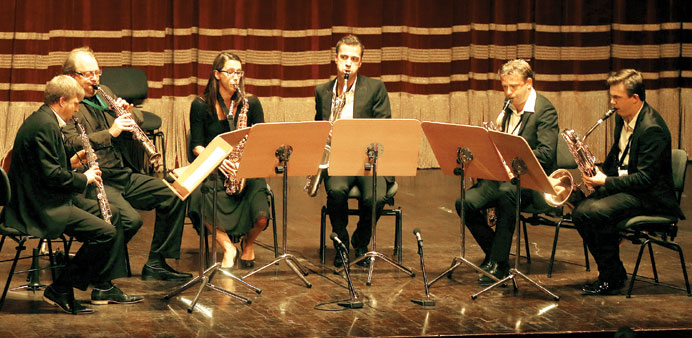The Belgian Saxophone Ensemble held the audience captive with some
scintillating compositions at Katara Opera House. By Umer Nangiana
Six mouthpieces, 60 fingers, 152 keys but just one aim: to play their hearts out.’ This was their motto and they remained true to it. The Belgian Saxophone Ensemble took the stage at Katara Opera House on Friday night before a packed house.
Hommage a’ Sax, the ensemble’s concert organised jointly by the Belgium Embassy in Qatar and The Cultural Village Foundation was a treat for music lovers who had turned up in large numbers. Director of the ensemble, Cezariusz Gadzina, the founder and the first conductor of the first European Saxophone Ensemble also having the title of European Cultural Ambassador, conducted the concert performed by six players on different types of saxophone.
The musicians, smartly attired in black and white, was an impressive sight. They played eight pieces over the two-hour long concert, which also included the first piece written for saxophone in 1842. “We started with a contemporary piece which was my composition, called Consaxations. It presented the saxophone with modern technique and choreography,” Gadzina told Community. The first piece was written specially for the ensemble. “We have quite a lot of work written specially for us,” the director added.
Then they came with Chant Sacre, the second piece written by Hector Berlioz in 1844. It was the first piece in which the saxophone was publicly presented in Paris as Adam Sax, the inventor of saxophone, was in the French capital at that time. He constructed the saxophone and Berlioz wrote the piece which was presented for the first time to an audience.
The longest performance of the concert, at 22 minutes, came with a Belgian, Jean Baptiste Singelee’s written piece Premier Quartor, the first piece written for a saxophone quartet in 1850.
“Later, we played a special piece written by Hanne Deneire who also wrote specially for us. In this we had to use 12 saxophones. But we were only six here so the composer had to reduce it to six,” said Gadzina, adding that for economic reasons the other six could not come with the ensemble and hoped that sometime in future they would.
“This piece also combined a kind of medieval European music which was modern as well. In fact, I really liked it that it was very special in Qatar where there is a lot of modernity and tradition going along together,” said the ensemble’s conductor.
“While playing I was thinking this is the perfect combination. It is very modern and very traditional at the same time,” he added.
It was the ensemble’s first ever performance in the Middle East. Gadzina said it was fantastic. The audience, he said, was very nice. It was really great and open.
About putting together the group, Gadzina explained that he was also the Director of the European Saxophone Ensemble which is the cultural ambassador for European Union. It has 12 different musicians from 12 different countries. “It is quite a colourful group and I did a lot of auditions for it. I went to every country and picked up the most suitable musicians. It started in 2008,” said Gadzina.
Alongside, they then came up with the idea that in some countries they could do it on the local or country level as well. “In Belgium, in fact, saxophone is very popular because a lot of young people like to play the saxophone,” said the director of the ensemble.
“I find it is a very nice instrument. Some people call it very ‘sexy’. Okay, it is very difficult to play on second level but on the beginner’s level it is not that difficult to play for example in comparison to violin where it is so difficult to create sounds for beginners,” Gadzina explained.
This was a big reason for the saxophone’s popularity among the youth in Belgium. Gadzina said it was relatively easy to play and he finds saxophone as a projection of his body. “What I cannot say in words I can tell via my saxophone,” said the master performer.



